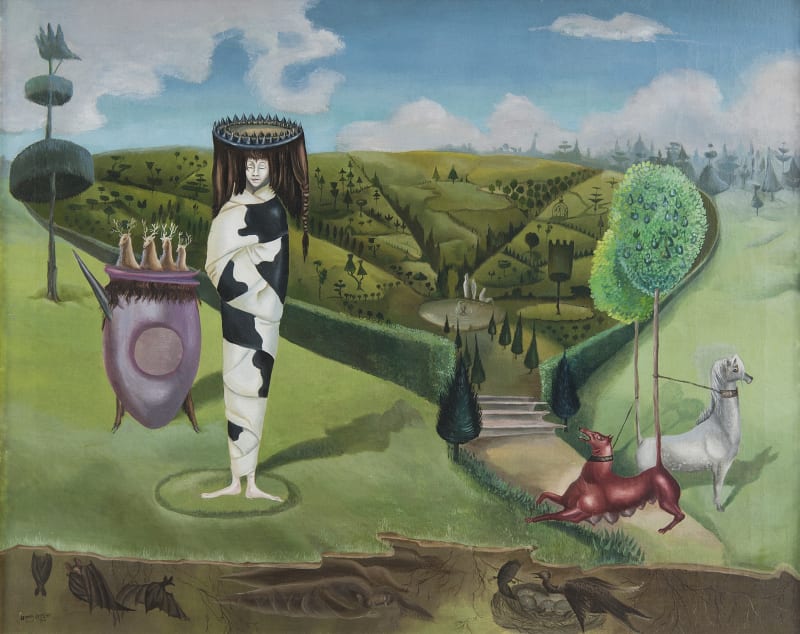16 October 2024
When Leonora Carrington‘s fanciful and dramatic 1945 canvas Les Distractions de Dagobert sold for $28.5 million at Sotheby’s New York in May—nearly ten times her previous record—it was the highest-profile example of a growing interest in Surrealism, particularly in its female artists, right in time for its centennial. “It’s been bubbling up for a while,” says Julian Dawes, head of modern and Impressionist art in New York for Sotheby’s.
And the interest shows no signs of abating this fall. On October 18 in Paris, Sotheby’s dedicates a sale to the movement. “Surrealism and Its Legacy.” Acorss the city, the Centre Pompidou continues the celebration with “Surréalisme,” a large exhibition that will travel to several European cities before ending its run in Philadelphia in 2026.
The movement was officially consecrated in 1924 by the writer André Breton, who incorporated ideas that had been brewing since the start of World War I into a manifesto, and it lasted well into the late 1940s. The historic conflicts and upheavals of those years led artists such as Max Ernst, Salvador Dalí, Yves Tanguy, and René Magritte to use disorienting, poetic, and dreamlike imagery. “It was an explosive era of creativity,” says Arizona collector James Coover, who owns more than 300 Surrealist pieces, among other artworks. “It’s spiritual, emotional art,” says San Francisco dealer Wendi Norris, who features Carrington at her gallery and counts Coover as one of her clients.
Norris attributes Surrealism’s resurgence to the tumult of the current moment. “Think about the time we’re living in now,” she says. “The rapid pace of technological evolution, the violence and autocratic regimes around the world. People feel unsettled.”
But as we look back on the heyday of the movement, we view its achievements through a wider lens. Norris says that for years the public thought Surrealism was just Dalí and Magritte. Now the women who worked alongside them in relative obscurity are driving the market and showing the largest increases in value. At Christie’s London in March, a Magritte canvas sold for a headline-making $43 million, but at the same sale, a record was set for Meret Oppenheim, a Swiss artist who is most famous for her fur-lined teacup called Object, which reigns as one of Surrealism’s most iconic pieces and resides at the Museum of Modern Art in New York.
Collectors like Coover—an entrepreneur who started paying attention to female Surrealists before the rest of the world—are looking quite prescient now. “For one thing, they were well priced,” Coover says of his first forays into the genre. His collection now includes paintings by American artists Kay Sage and Dorothea Tanning, who was an important late-stage Surrealist, as well as Argentine Italian Surrealist Leonor Fini. “I also have one of the largest works Carrington ever did,” he says of the British Mexican artist, who had been perhaps the best-known female Surrealist even before her record sale in May. “For a while they were just seen as muses. But now there’s been an awakening to how much talent was out there. They never received the notoriety that their art deserves.”
For his part, Dawes thinks the burgeoning interest in women Surrealists is just getting started. “What’s exciting about the female artists is that masterpieces like the one we just sold in May are still in private collections,” he says, meaning that they could still turn up in a gallery backroom or at auction. “That’s not the case with Dalí.”
New York theatrical producer Jenna Segal has a very specific approach to collecting works from the period: Since 2020, she has focused on buying at least one piece by every artist featured in the famed “Exhibition by 31 Women,” presented by Peggy Guggenheim in 1943 at her New York gallery, Art of This Century. The show is thought to be the first in the U.S. to highlight examples by women practitioners exclusively, and it happened that many of them worked in a Surrealist vein at some point in their careers. “They were less doctrinaire than the men,” Segal says of the way the women pursued their visions outside of the strictures set by Breton. Part of it, she notes, is that they were chafing at other constraints put on them by society because of their gender. “They were seeking freedom from the lives they were inhabiting.”
This year, Segal completed her collection—selections from which are gathered in “31 Women Collection,” an exhibition on view in Madrid through January 5, 2025—and the trove includes pieces by Swiss artist Sophie Taeuber-Arp and the legendary Frida Kahlo. “The Carrington record shows that museums, and the rest of us, are realizing that we left a lot of people out,” says Segal, who points to American artist Julia Thecla and French painter Jacqueline Lamba as lesser-known names poised to grow in market power. “It’s the coolest story never told.”
A version of this article first appeared in print in our 2024 Collectors Issue under the headline “Real Assets.” Subscribe to the magazine.




